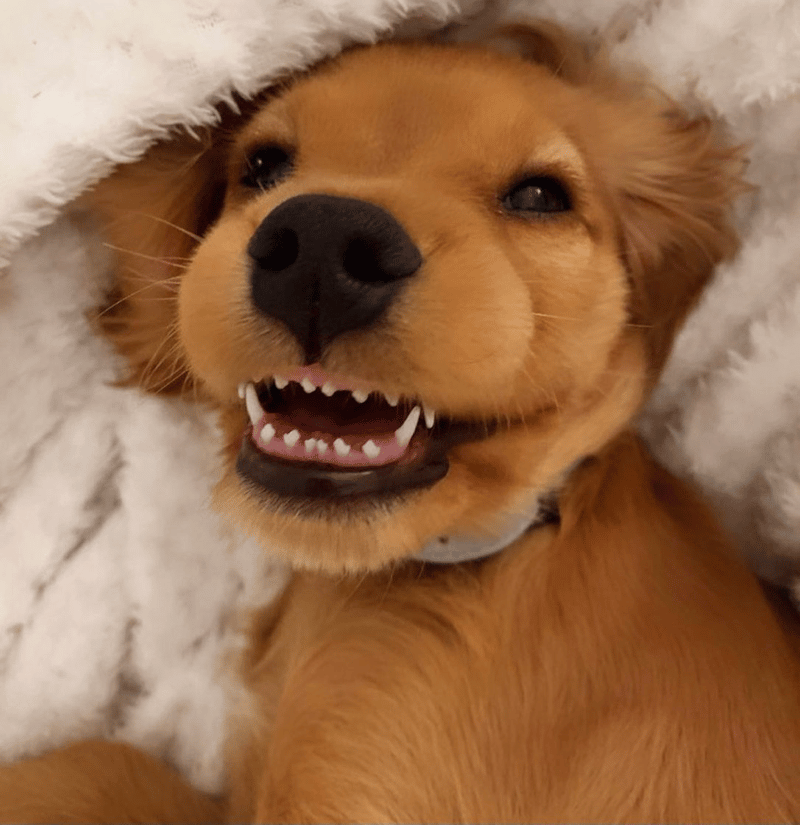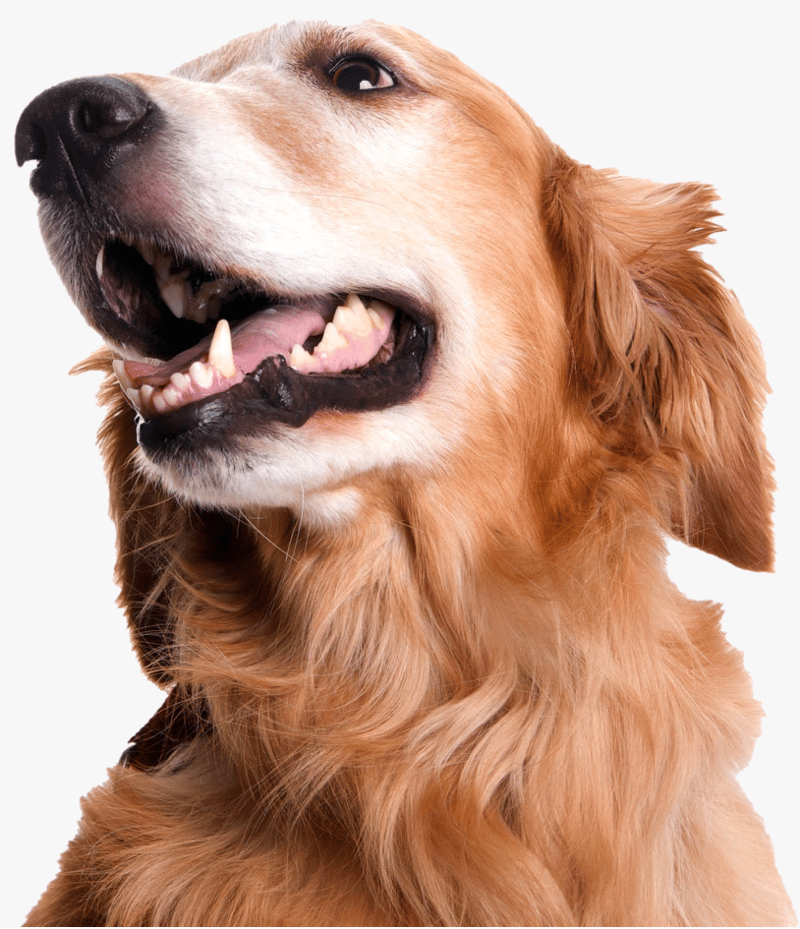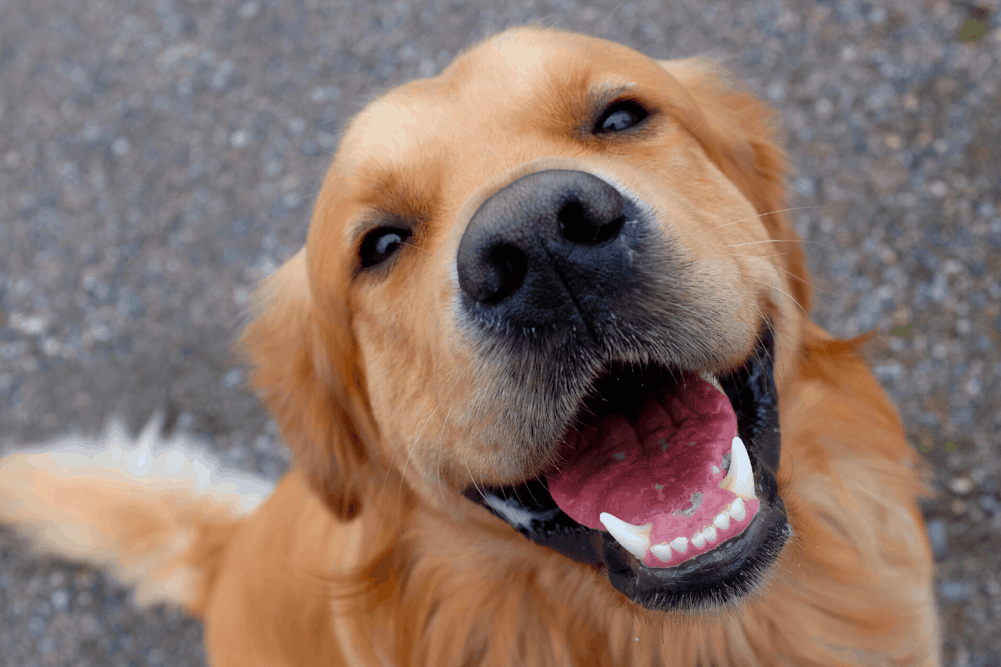Contents
- The First Stage: Your Golden Retrievers Baby Teeth Development
- The Second Stage: Their Permanent Teeth Growth & Development
- What Happens to Your Golden Retrievers Baby Teeth?
- 7 Tips to Helping Your Golden Retriever Through the First Stage
- Growth and Development for a Golden Retriever
- Teaching Your Golden Retriever Not to Bite
- Conclusion
- Golden Retriever Resources and Tips
A Golden Retriever’s puppy teeth begin growth and development at 3 weeks of age and last about 4-6 months, after which the first teeth are replaced by adult teeth.
Golden Retrievers go through two main stages of their teeth development and growth. The first stage is the baby teeth and it’s when they go chew crazy, then the second stage is where the permanent teeth will make an appearance and replace those baby teeth.
The First Stage: Your Golden Retrievers Baby Teeth Development

- What are the signs of teething?
- How long does it take to grow new teeth?
- Do Golden Retrievers ever stop chewing?
The teething fun begins at around three weeks of age. Often called their milk or deciduous teeth, it is a very deceptive name for what turns out to be a set of 28 very sharp first teeth.
You will know when the teething starts, as your puppy will constantly want to chew. They will chew anything they can get their gums into. Just as human baby gets fretful when they get their first teeth, so too does your Golden Retriever puppy. Not only that, but you will also notice that they start to bite and chew everything including you! And those little bites are painful.
Chewing helps to relieve the pain in their gums and soothes the irritation of the new milk teeth coming through.
Your young Golden Retriever explores the world through their mouth; they taste what an object is like, they destroy it to find out how strong it is, and chewing is a comfort if they are fretful or bored.
The cycle of teeth. Nature determines when your puppy gets their first teeth.
| Day of birth | Puppies are born without any teeth. |
| 2-3 Weeks of age | The 12 incisors begin to appear. |
| 4- 5 weeks | Four canines start to appear |
| 3-6 weeks | Premolars appear within this timeframe |
| 6-8 weeks | By now, your puppy should have all their milk teeth which consist of 28 teeth. |
Just to reiterate the process, the milk teeth appear when they reach 2-3 weeks old, beginning with the incisors that number six on the top, and six on the bottom.
After that, at around 4 weeks, they will get their four canines, which are sharp long teeth.
Those sharp teeth encourage the mother dog to begin weaning! The mother dog will discipline a pup that causes her pain, and the puppies’ siblings won’t want to play if they get hurt by a biting pup. This is when a puppy can be introduced to a mushy mix of food which prepares the young dog for solids.
Basically, a full set of teeth for your Golden Retriever consist of 12 incisors, 4 canines, and 12 pre-molars – a total set of 28 nice sharp teeth.
They must also learn that biting people is not acceptable, so as the owner of your Golden Retriever, you must walk a tightrope to balance the acceptable with the unacceptable teething traits practiced by your little pooch.
And you must watch them like a hawk because anything and everything is fair game to a young Golden Retriever who is teething. Many a puppy has been rushed to the vets because they chewed and swallowed something that was not good for their digestion such as chunks of plastic or rubber!
As far as when they stop chewing … the Golden Retriever never really stops. They chew as an adult if they are bored, they chew for comfort, and they chew just because they can. But they will be more controlled and will be able to be trained as to what is appropriate for them to chew on.
The Second Stage: Their Permanent Teeth Growth & Development

- When do their permanent teeth grow in?
- How many permanent teeth do they get?
- Can you train your young dog not to bite?
Golden Retriever owners usually sigh with relief as their puppy starts the second stage of their dental growth and the development of their permanent teeth.
Between 4-6 months of age, the permanent teeth come up very quickly and push the milk teeth out so you will rarely notice any gaps in their teeth.
The adult incisors should be in place by the time your Golden Retriever is 5 months of age. Once they are in place, the milk teeth and canine teeth will be replaced by adult canines, followed by premolars, and lastly the molars. The complete set of adult teeth should be complete by 7-8 months.
Your puppies’ new teeth should comprise 12 incisors, 4 canines, 16 premolars, and 10 molars. Or in other words, they should have 42 brand new teeth.
Providing plenty of safe things for your Golden to chew on will help with the painful transition from milk teeth to adult teeth.
And once the permanent teeth settle in, you will notice that your little chewing monster will bite, and chew less than they used to. They will also become easier to train to stop biting people. Clicker training is ideal, as the click noise gets your young dog’s attention, and the treatment for stopping what they were doing is motivation to obey.
Make sure you supply your growing pup with plenty of chew toys, ropes, and special treats that are designed to help keep the new teeth sparkling white.
Remember to regularly check your Goldens toys for any broken or torn bits. You don’t want your dog to ingest anything foreign or unacceptable in case it becomes a health issue.
The Golden Retriever will continue to chew throughout their lives but by then they will know what the best things are to chew and what is out of bounds.
What Happens to Your Golden Retrievers Baby Teeth?
It is strange to note that not many owners find the milk teeth lying around. What happens to those sharp little incisors?
This may seem a bit alarming, but they are usually swallowed by your Golden Retriever while they are eating. But don’t worry, it is not a cause for alarm as the tiny teeth will pass easily through their system.
When you note what your Golden manages to eat and trust me, they will try to eat or chew just about anything, a few tiny milk teeth are going to seem like nothing in comparison.
Occasionally you may find them playing with something on the floor, and you may find a small pearly white tooth, but often your dog will just gobble it down intentionally or otherwise and you will never see them.
Losing their teeth is entirely part of the growing stages in your Golden Retrievers’ life. The chewing helps to dislodge the baby teeth when the new permanent teeth are coming through.
Chewing also massages the gums and offers relief to a suffering pup.
7 Tips to Helping Your Golden Retriever Through the First Stage
There are several things you can do when your Golden is going through the teething developmental stage.
1. Give your puppy toys that have a lot of ridges and bumps on the surface. The bumps help to massage the gums and give a measure of relief to your Golden puppy.
2. If their gums are bleeding, and this is a natural thing, try freezing the toy so that it is cooling and will relieve the bleeding when they chew.
3. Train your puppy to let you put your finger in their mouth and you can use small pieces of ice to massage their gums. Teaching them to allow your finger in their mouth without biting it is good training for later when you want to clean their teeth.
4. Your Golden Retriever puppy may lose their appetite when they are teething. Try giving your puppy some dry food as opposed to wet food as it is good for the development of strong gums and teeth. Don’t worry if they don’t want to eat, that won’t last long as all puppies love their food!
5. Provide your teething puppy with plenty of ropes and strong resilient toys to chew on or your beloved dog will use your best shoes, your handbag, and anything else they can find.
6. Specialty toys designed for a teething dog can also be frozen and provide relief on chewing.
7. Old rags are ideal for a chew toy. Wet them down, tie them in knots in several places, and put them in the freezer. When your dog chews crazy, throw them a rag and they will chew on it for ages. When your dog is finished chewing on a rag, rinse it off and refreeze for later. This is a cheap easy teething aid for your Golden. Try to use a strongly woven fabric, so that it can withstand your puppy’s chewing.
Growth and Development for a Golden Retriever

During the first year of your Golden Retrievers’ life, they will go through several changes as they develop and grow into adult dogs.
Patience and time are required during this stage. If you stay alert, you can guide them gently through it all by quietly taking unacceptable things that they are chewing on and replacing them with a toy of theirs.
If you provide plenty of exercise time, lots of toys to play with, and appropriate chew toys during this transition time, it will be easier for your puppy.
Puppies bite and chew for many reasons:
- They explore the world through their mouth – taste and texture are important as they learn about their world.
- Part of the biting and chewing is part of how your Golden plays. They don’t use their paws to catch or explore, they use their mouth and teeth to catch, retrieve and give you sloppy kisses to show how much they love you.
- A Golden Retriever has been bred to use their mouths to retrieve the game and return it unharmed to their master. They learn through play what an acceptable pressure is likely to be.
- During the developmental teething stage, chewing and biting help to relieve the pain in their gums.
- And when they are bored or lonely, chewing helps them to feel better.
Teaching Your Golden Retriever Not to Bite
Understanding that your lovely Golden Retriever is going through a painful development teething stage is important.
But just as important is that they still need to be taught what is acceptable behavior and what is not. If you leave it too late such as after the teething stage, they will have some ingrained habits such as chewing the furniture and clothing which takes some training to overcome.
Yelling or punishing a young dog is never appropriate and can break a Golden Retrievers’ spirit. If you are prepared for the first year of your dog’s life, it will be much easier to divert your dog’s habits along the right lines.
- Replace chewing on the wrong thing with a firm but quiet ‘no’ and give them something else to chew on.
- Be realistic and put your best shoes away up high. It amazes me that people repeatedly leave them on the floor just where your Golden can find them. Don’t tempt fate, put them up high and your dog won’t be able to reach them.
- Have a small toy handy when you sit and play with them. When they try to bite you, a quiet ‘no’ and giving them the toy will help divert their activity.
- Use a clicker to train a young dog. The noise of the clicker will get their attention and they should stop and look at you. When they do, give them a reward for stopping, and then lead them onto another activity.
- Keep them busy. If you can wear out your Golden Retriever, they will eventually collapse and go to sleep. There is nothing so sweet as your puppy twitching and woofing in their sleep.
Conclusion
The teething process takes place in the first year of your Golden Retrievers’ life. While it may seem a very long year to Golden Retrievers owner, it does pass, and life becomes less of a watchful state and becomes more fun both for your dog and as an owner.
There is no doubt that cutting new teeth is a painful rite of passage, and it requires patience on behalf of all owners who have young dogs.
Even though your little Golden is only trying to find relief from the pain and is not being intentionally naughty, they must be guided on what is acceptable behavior and what is not.
Don’t just stop them from doing something you don’t approve of but offer them an alternative such as an ice cube to suck or a piece of firm rope to chew.
If you can stay one step ahead of your Golden Retriever during their first year, so much the better. Being prepared and using distraction tactics will ease you both through this unsettled stage.
An offering of a new toy, taking them for a walk to distract them, or giving them a frozen broth block to lick will keep them happy. If you provide what your Golden Retriever needs during the difficult teething and development stage, you will remain one step ahead of your puppy as they go through the difficult tooth development and growth stages.
Golden Retriever Resources and Tips
- Golden Retrievers: History, Types, Temperament, Health and Behaviors
- Types of Golden Retrievers: Decoding Their Colors and Patterns
- How Long Do Golden Retrievers Live?
- Full Breakdown Cost to Buy and Raise A Golden Retriever
- 6-Week-Old Golden Retriever: Developmental Milestones to Expect
- 8-Week-Old Golden Retriever: Growth, Developmental and Behavioral Expectations
- 3-Month-Old Golden Retriever: Training, Feeding, Sleeping
- 4-Month-Old Golden Retriever: Training, Feeding, and Behaviors
- 5-Month-Old Golden Retriever: Behaviors, Feeding, and Training
- 6-Month-Old Golden Retriever: What to Expect from Canine Adolescence
- 7-Month-Old Golden Retriever: Full-Blown Adolescence
- 8-Month-Old Golden Retriever: Behavior, Training and Development
- 23 Essential Things to Buy for Your New Golden Retriever Puppy
- Complete Beginner’s Guide to Train Your Golden Retriever Puppy
- Golden Retriever Common Health Issues: Symptoms, Treatments, and Prevention
- How Much Exercise Golden Retrievers Actually Need (Puppies, Adults, Seniors)
- Do Golden Retrievers Shed A Lot? And What to Do
- At What Age Does A Golden Retriever’s Teeth Develop and Grow?
